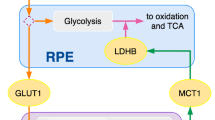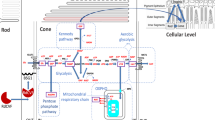Abstract
Understanding the essential components and processes for coexistence of rods and cones is at the forefront of retinal research. The recent discovery on RdCVF’s mechanism and mode of action for enhancing cone survival brings us a step closer to unraveling key questions of coexistence and codependence of these neurons. In this work, we build from ecological and enzyme kinetic work on functional response kinetics and present a mathematical model that allows us to investigate the role of RdCVF and its contribution to glucose intake. Our model results and analysis predict a dual role of RdCVF for enhancing and repressing the healthy coexistence of the rods and cones. Our results show that maintaining RdCVF above a threshold value allows for coexistence. However, a significant increase above this value threatens the existence of rods as the cones become extremely efficient at uptaking glucose and begin to take most of it for themselves. We investigate the role of natural glucose intake and that due to RdCVF in both high and low nutrient levels. Our analysis reveals that under low nutrient levels coexistence is not possible regardless of the amount of RdCVF present. With high nutrient levels coexistence can be achieved with a relative small increase in glucose uptake. By understanding the contributions of rods to cones survival via RdCVF in a non-diseased retina, we hope to shed light on degenerative diseases such as retinitis pigmentosa.





Similar content being viewed by others
References
Aït-Ali N, Fridlich R, Millet-Puel G, Clérin E, Delalande F, Jaillard C, Blond F, Perrocheau L, Reichman S, Byrne LC et al (2015) Rod-derived cone viability factor promotes cone survival by stimulating aerobic glycolysis. Cell 161(4):817–832
Byrne LC, Dalkara D, Luna G, Fisher SK, Clérin E, Sahel J-A, Léveillard T, Flannery JG (2015) Viral-mediated rdcvf and rdcvfl expression protects cone and rod photoreceptors in retinal degeneration. J Clin Investig. 125(1):105–116
Camacho ET, Wirkus S (2013) Tracing the progression of retinitis pigmentosa via photoreceptor interactions. J Theor Biol 317C:105–118
Camacho ET, Colón Vélez MA, Hernández DJ, Bernier UR, van Laarhoven J, Wirkus S (2010) A mathematical model for photoreceptor interactions. J Theor Biol 21:638–646
Camacho ET, Melara LA, Villalobos MC, Wirkus S (2014) Optimal control in the treatment of retinitis pigmentosa. Bull Math Biol 76(2):292–313
Colón Vélez MA, Hernández DJ, Bernier UR, van Laarhoven J, Camacho ET (2003) A mathematical model of photoreceptor interactions. Department of Biological Statistics and Computational Biology Technical Report BU-1640-M, Cornell University, pp 25–69
Cronin T, Léveillard T, Sahel J-A (2007) Retinal degenerations: from cell signaling to cell therapy; pre-clinical and clinical issues. Curr Gene Ther 7(2):121–129
De Zutter JK, Levine KB, Deng D, Carruthers A (2013) Sequence determinants of glut1 oligomerization: analysis by homology-scanning mutagenesis. J Biol Chem 288:20734–20744
Fain GL, Lisman JE (1993) Photoreceptor degeneration in vitamin a deprivation and retinitis pigmentosa: the equivalent light hypothesis. Exp Eye Res 57:335–340
Krol J, Roska B (2015) Rods feed cones to keep them alive. Cell 161(4):706–708
Léveillard T, Mohand-Saïd S, Lorentz O, Hicks D, Fintz A-C, Clérin E, Simonutti M, Forster V, Cavusoglu N, Chalmel F, Dollé P, Poch O, Lambrou G, Sahel JA (2004) Identification and characterization of rod-derived cone viability factor. Nat Genet 36(7):755–9
Mei X, Chaffiol A, Kole C, Yang Y, Millet-Puel G, Clerin E, Ait-Ali N, Bennett J, Dalkara D, Sahel J-A, Duebel J, Leveillard T (2016) The thioredoxin encoded by the rod-derived cone viability factor gene protects cone photoreceptors against oxidative stress. Antioxid Redox Signal 24(16):909–923
Real LA (1977) The kinetics of functional response. Am Nat 111:289–300
Yang Y, Mohand-Said S, Danan A, Simonutti M, Fontaine V, Clerin E, Picaud S, Léveillard T, Sahel J-A (2009) Functional cone rescue by rdcvf protein in a dominant model of retinitis pigmentosas. Mol Ther 17:787–795
Acknowledgments
This work was supported by Sanofi (RdCVFAgo), UPMC (endowment), Inserm (endowment), CNRS (endowment), EC (HEALTH-F2-2010-241683-RDCVF), FFB (C-NMT-091 2-0602-INSERMO4), ANR (AA-BLANC-SVSE1), and LABEX LIFESENSES (ANR-10-LABX-65).
Author information
Authors and Affiliations
Corresponding author
Rights and permissions
About this article
Cite this article
Camacho, E.T., Léveillard, T., Sahel, JA. et al. Mathematical Model of the Role of RdCVF in the Coexistence of Rods and Cones in a Healthy Eye. Bull Math Biol 78, 1394–1409 (2016). https://doi.org/10.1007/s11538-016-0185-x
Received:
Accepted:
Published:
Issue Date:
DOI: https://doi.org/10.1007/s11538-016-0185-x




